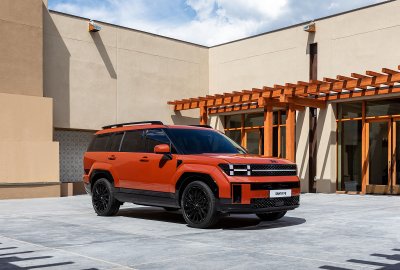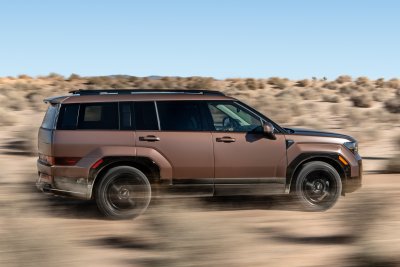The three-row SUV market is now both broader and deeper than ever before. Its SUVs come in a wide range of sizes, from the diminutive Land Rover Discovery Sport (181 inches) to the hulking Cadillac Escalade ESV (212 inches). They span segments from compact to midsize to large, along with plenty of tweeners, which is where the redesigned and brutally boxy 2024 Hyundai Santa Fe resides.
Hyundai calls the breadbox a "compact SUV," though it admits at 190 inches it is bordering on midsize. What buyers really get is the best of both worlds here. The shape leads to the interior feeling spacious, even in the third row, yet on the road, its driving dynamics make it feel not-quite nimble, but certainly smaller than its exterior looks suggest. Surprisingly, it's not half bad off road either.
The fresh look was unveiled in Santa Fe, New Mexico, at the end of last year. Up front there are H-shape and horizontal LED lamps, Hyundai notes they used to be just for its electric vehicles (EVs), along with active air flaps, which maximizes efficiency and leads to better gas mileage.
The 2024 Santa Fe comes with a roof rack, accessible by climbing on the rear wheels and using the new pop-out hand holds, and there's, more glass and less pillar width, leading to better views when backing up.
Hyundai noted that the new model is only 2 inches longer than the outgoing one, though it looks much bigger.


The rear gets its own set of H-style lamps with a new flat Hyundai badge and spoiler-hidden rear wiper. The tailgate has a huge opening, 2 inches taller and almost 6 inches wider than the last Santa Fe, along with 4 more cubic feet of space behind that third row. For comparison, the Hyundai Palisade is about 6 inches longer, 3 inches wider and about 3 inches taller.
Read more: How to Buy a Car With No Credit
Hyundai said it wanted to blur the boundaries between city and country life with the Santa Fe. Camping and working. It said that taking a weekend camping trip usually isn't an a-to-b affair, with stops at school, grocery stores and other places along the way, all adding to the requisite stuff needed for an off- or on-the-grid vacation.
The 2024 Hyundai Santa Fe is offered in 5 trims from SE front-wheel drive ($33,950) to the Calligraphy all-wheel drive ($48,800), all starting with a 277-horsepower (hp), 311 pound-feet (lb-ft) of torque turbocharged four-cylinder. An eight-speed dual-clutch transmission (DCT) is standard and one of the most impressive in a non-enthusiast vehicle. It's almost unnoticeable in automatic mode with none of the jerkiness that some DCTs are known for.
The turbo four-cylinder, too, is plenty peppy with two occupants in the vehicle, possibly even overpowered for vehicle in this class. But of course, it fits six or seven people and with an extra 600 pounds to pull around an owner will need all 311 of those pound feet.


The new Santa Fe comes in at an Environmental Protection Agency (EPA) estimated 24 miles per gallon (mpg) combined in front-wheel drive with the standard engine. The hybrid, landing in April or May, ups that to 35 mpg combined.
The hybrid model will use a 1.6-liter turbo four-cylinder making 231 hp and 271 lb-ft of torque.
On the road in the mountains of Tennessee, the 2024 Santa Fe felt smaller than its visual footprint when sweeping around curves and when on the expressway. A quick stab of throttle drops the transmission down a few gears for maximum power for passing maneuvers and on the brakes too, the vehicle felt easy to control.
The single suspension option was fine both on and off the road, maybe a bit stiffer than expected in a vehicle like this, however, it was surprisingly capable in the XRT off-road trim on rocky mountain trails. It has a bit of extra ground clearance but no Off-Road driving mode.
It does come with hill descent control, which uses all four brakes to safely roll down a decline. There's also a four-wheel drive lock button, which confidently moves power around the vehicle until it finds a wheel with traction. At several points one or more tires was in the air, after a few seconds of adding throttle pressure it found the correct wheel and continued on.
On those trails, and on the road, the engine was surprisingly quiet, even with the windows down. There was more noise from the tires crunching over the gravel and squishing through the mud than the engine off-road. Only when the rpms reached 2,200 was there some grunt and growl. The standard towing capacity is 3,500 pounds, but through increased cooling on the XRT trim that increases to 4,500 pounds.


The Santa Fe Calligraphy trim we mostly tested is the top of the line meaning leather seats with great adjustment, especially for the driver, and modern wood-look trim running around the dashboard and doors. It keeps the H theme alive with horizontal air vents accents and ambient lights. When looking towards the rear from the driver's seat the cabin looks cavernous.
The new interior has a new ultraviolet compartment above the glove box that sterilizes phones, wallets, keys and other objects, along with a dual wireless charging system. A curved display combines the 12.3-inch digital gauge cluster and 12.3-inch touchscreen infotainment system. Wireless Apple CarPlay and Android Auto are now standard along with several USB-C charging ports in different rows.
Like other Hyundais, the Santa Fe also offers a Digital Key for vehicle access, startup, and remote control via the owners' smartphone. It also includes Hyundai Pay, which allows drivers to pay for parking or fuel from inside the vehicle at certain locations.
Read more: How to Refinance a Car Loan
The second- and third- rows of seats are fully foldable leading to a flat loading surface, or relaxation space when out of doors. One of the representatives said he bought an air mattress and slept in the Santa Fe, using the second row cupholders as a bedside table. The third row is better than most in the smaller size class, offering room for a 5-foot, 10-inch adult behind another 6-foot adult.


The second row slides fore and aft, allowing for more interior customization. That row can be optioned in bench or captain's chairs configuration. Finally, the Santa Fe now offers a new center armrest that opens to both the front and back passengers for added convenience. Overall, it's comfortable space to spend hours on the road, or parked and lounged in the fully reclining front seat.
Forward Collision-Avoidance Assist, Blind Spot Warning, Lane Following Assist and Driver Attention Warning are standard. Hyundai now added Forward Attention Warning that uses an infrared camera mounted on the steering column to help track a driver's eye gaze and monitor attention levels.
Navigation-based Smart Cruise Control, Highway Driving Assist, Intelligent Speed Limit Assist, Rear View Monitor, Rear Cross-Traffic Collision-Avoidance Assist, Front and Rear Parking Distance Warning, Surround View Monitor, Remote Smart Parking Assist, and Safe Exit Assist are all optional.
The 2024 Hyundai Santa Fe will compete with a wide range of three-row SUVs. There's a group that rarely needs the third row, and therefore can live with one of the smaller options.
A big family not only needs a big third row, but also more extra cargo space. Hyundai named the Kia Sorento ($33,365), Honda Passport ($41,900) and Subaru Outback ($28,895) as competitors, though only the Sorento has a third row. Hyundai also says it could compete with even larger vehicles like the Toyota Highlander ($39,270).
Read more: Compare Top Auto Loan Refinance Lenders
A vehicle that feels big on the inside while not feeling big on the road is the highest level of automotive engineering. It's easier to do with a big engine and small chassis, however the opposite is much more difficult.
Uncommon Knowledge
Newsweek is committed to challenging conventional wisdom and finding connections in the search for common ground.
Newsweek is committed to challenging conventional wisdom and finding connections in the search for common ground.
About the writer
Jake Lingeman is the Managing Editor for the Autos team at Newsweek. He has previously worked for Autoweek, The Detroit ... Read more
To read how Newsweek uses AI as a newsroom tool, Click here.





